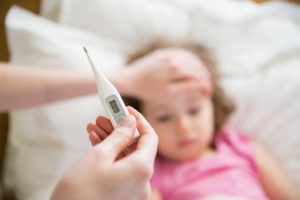Scarlet fever in children is still one of the most common infectious diseases. People of any age can fall ill. However, the disease mainly occurs in babies and children. Fortunately, scarlet fever in children is no longer life-threatening. Since the disease is transmitted in most cases by droplet infection, self-protection is never one hundred percent possible, especially in the cold season.
Everything you need to know about scarlet fever in your child can be found in this article.
Table of contents
Scarlet Fever In Children: This Is The Pathogen
The cause of scarlet fever in a child and of course in an adult is bacteria. More precisely, the pathogens are streptococci, which are assigned to the group A. Of this type, there are about 80 different types.
Normally, all these types of bacteria cause streptococcal angina. This is an inflammation in the throat. However, scarlet fever itself is the special form of streptococcal A infection. It is caused by special strains of streptococcus types.
These additionally produce a special scarlet fever toxin. This in turn triggers the typical scarlet rash. This course of the disease basically makes scarlet fever a streptococcal angina with rash.
Scarlet Rash With Typical Features
Once scarlet fever has broken out in a child, it is quite easy to identify. This is because the rash on the skin has a typical appearance. It consists of many spots lying close together, not much bigger than the heads of pins.
If you stroke the skin of your sick child with the surface of your hand, it will feel like sandpaper or resemble a slight goosebump. At first, the bumps of the rash are pale pink. Over time, they later turn flaming red. This is where the term scarlet comes from.
In contrast, the skin on the face of the patient remains smooth. However, it is also intensely reddened. Around the mouth and the part of the chin, the skin remains exempt from redness. A little reminds me of a milk beard.
Alarm Signs In The Throat And Oral Cavity
At the latest when looking into the oral cavity, a disease then reveals itself completely. The throat of a sick child is dark to dusky red. In the beginning, the tongue still shows a whitish-yellow coating. However, this is shed after about one to two days.
Then the tongue is also noticeably reddened on its surface. It also swells additionally and resembles a strawberry. After a few days, the skin begins to flake. The inner surfaces of the hands and the soles of the feet are particularly affected.
Take A Close Look
Scarlet fever in children is much easier today in a few cases than it was for a few decades. If your child has trouble swallowing and a red throat, you need to take a closer look to identify scarlet fever in children.
Because in milder cases, the rash on the body is only pale pink, sometimes it even occurs for only a few hours. There are also scarlet fever cases that run completely without a rash. Then, only after a few days, flaking of the skin shows that the child had scarlet fever.
Easy To Confuse: The Hand Mouth Foot Illness
Inflammation of the throat and mouth does not always indicate scarlet fever in a child. In the early stages, scarlet fever in children is often confused with hand foot, and mouth disease. Hand foot and mouth disease occurs mainly in children under ten years of age.
When a child becomes infected with the disease, episodes of fever set in. After about one to two days, small red spots form on the oral mucosa, gums, and tongue. These are extremely painful. After a short time, they develop into vesicles or even ulcers.
As the term hand mouth foot already suggests, the rash moves on to the hands and feet only a few hours later. Now the diagnosis is clear. Again, the blisters and small ulcers are very painful and itchy.
The rash on the hand’s mouth and feet secretes a secretion. Caution: It contains viruses, with which the hand foot mouth disease the lightning is transmitted further. Therefore, the hand foot mouth disease has the reputation of being highly contagious.
If your child has contracted the disease, it takes three to ten days for the first symptoms to appear. The highest risk of infection is when the rash appears.
Ways Of Transmission: How Scarlet Fever Gets To The Child
Pathogens are transmitted in different ways.
In The Case Of Scarlet Fever, Two Types Of Infection Are Possible:
- Droplet infection.
- Smear infection.
Droplet Infection
In droplet infection, the pathogens of a disease that settle in the respiratory tract or throat become airborne when people speak, sneeze, or cough with tiny droplets of saliva. They are then inhaled by other people. They can also be absorbed directly through the mucous membranes in the mouth. This happens, for example, when kissing.
The danger is everywhere. Some pathogens float in the air in tiny droplets smaller than five-millionths of a millimeter for long periods of time. They are therefore also spread over long distances and infect you or your child, even though you have come into contact with a sick person.
Infection Via Surfaces
Smear infections are contact infections. Pathogens are transmitted by touch, for example from person to person. Or they travel from one person to another via soiled objects and surfaces.
Danger comes from the hands. They are often reflexively and unconsciously brought to the face and mouth. At the latest then the pathogen is taken up.
Scarlet fever in children is highly infectious.
Babies can also be infected with the disease from as early as six months of age. Until then, the little ones still have the “nest protection” from their mother. Scarlet fever in children occurs most often between the third and eighth birthdays.
A peak is around the fourth year of life. The risk of infection decreases at around ten. However, it never completely disappears.
Even Healthy People Can Transmit The Disease
The pathogens preferentially travel from one person to another via droplet infection. Of course, you can protect yourself and your child from transmission by coughing or sneezing people. But this is only possible to a certain extent.
It is not enough, for example, to avoid people who are already ill. In Germany, one in five to one in ten people carry the scarlet fever pathogen in their body without having fallen ill themselves. However, this person then passes the streptococci on to others.
For example, bacteria from the throat are also released into the air when your healthy counterpart speaks. If the bacteria are streptococci, they will cause scarlet fever in the child or in you if you breathe in this air.
Once Scarlet Fever In The Child – But Not Protected Forever
Unfortunately, surviving scarlet fever does not build up reliable protection. This is where scarlet fever differs from most childhood diseases. Once the disease is overcome, it does not make you completely immune.
This is due to the streptococci, i.e. the bacteria responsible for the infection, which travel virtually all over the world. Depending on the strain, the streptococci form different toxins, also known as toxins.
Against them, the human immune system is able to form antibodies. If the patient has survived a scarlet fever illness, he or she will be immune to the toxins of this pathogen in the future. However, since individual strains of streptococcus produce different toxins, you and your child can get scarlet fever more than once.
Treatment Of Scarlet Fever In Children
As mentioned earlier, scarlet fever is a disease caused by bacteria. This also distinguishes it from hand foot mouth disease, which is caused by viruses. Scarlet fever is therefore fought with an antibiotic. As the drug of choice, the doctor administers penicillin.
Caution – Do Not Take It Lightly
Penicillin has had an excellent reputation as an antibiotic since its discovery. With the help of treatment with the active substance, your child will be well again after only 24 to 48 hours. But this does not make the disease less dangerous!
On the contrary, the fact that the symptoms disappear does not mean that the streptococci are gone. You must make sure that the antibiotic prescribed by the doctor is given to your child long enough. Ten days are indicated.
Despite Medical Progress, There Is Still No Reason To Sound The All-clear
Just over a century ago, this infectious disease was compared to plague, cholera and typhoid fever. In some outbreaks, the mortality rate was 20 percent. Sometimes even half of the children infected with scarlet fever died.
The poet Friedrich Rückert wrote his “Kindertotenlieder” around 1830 when two of his ten children had scarlet fever. Later, the composer Gustav Mahler set them to music. His daughter Maria Anna also died with was five years old from infectious disease.
Scarlet Fever In Children: Do Not Underestimate The Risk Of Late Complications
Therefore, even today the risk of scarlet fever should not be underestimated. The disease can still have dangerous consequences for your child – despite the good prognosis of a therapy with antibiotics.
It can be problematic, for example, if you belong to the group of parents who refuse antibiotic treatment. Remember that this can harm your child. If left untreated, germs can lead to diseases such as.
- Chronic rhinitis.
- Ear infections.
- Swelling of the lymph glands.
- Abscesses in the throat and tonsils.
Without antibiotics, the disease lasts more than five weeks. After about four weeks, rheumatic fever often joins the already distressing symptoms. This often results in changes in the joints, associated with pain and swelling, as well as permanent movement restrictions.
A high risk is furthermore the so-called scarlet heart. This is an inflammation of the heart muscle and the heart valves. There is also a risk of acute kidney inflammation.
Before penicillin was available, scarlet fever sufferers were completely isolated for a period of six weeks. The home was thoroughly disinfected, and all items used by a sick child were burned.
While a child treated with antibiotics is no longer at risk of infection after two days, children without such treatment are considered “infectious” for three weeks. According to Section 34 of the Infection Protection Act (IfSG), they are not allowed to attend daycare or school until, in the opinion of a physician, they no longer pose a risk of infection.
Vaccination Against Scarlet Fever
Research is still being conducted on a vaccine against scarlet fever. But even after many years of intensive research, scientists have not yet achieved a breakthrough. The reason is the diversity in the A-streptococcus group, which has already been described. A broad-spectrum vaccine that can eliminate virtually all pathogens would have to be found.











1 thought on “Scarlet Fever In A Child: These Are The Signs Of The Contagious Disease”